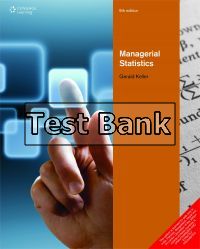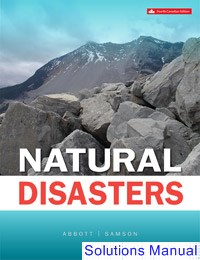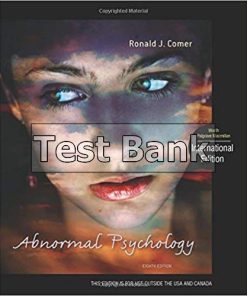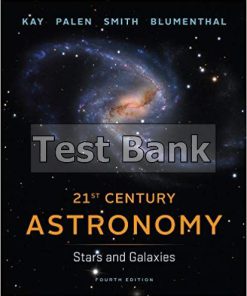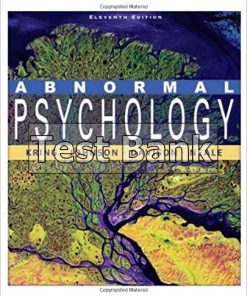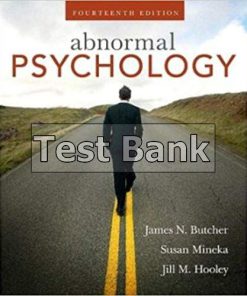Natural Hazards Canadian 3rd Edition Keller Test Bank
You may also like
-
$26.50
$50.00
Natural Hazards Canadian 3rd Edition Keller Test Bank
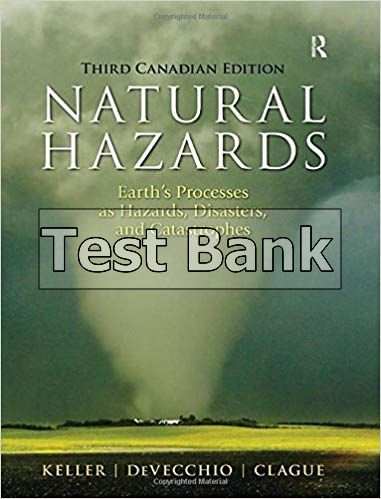
Product details:
- ISBN-10 : 0133076504
- ISBN-13 : 978-0133076509
- Author:
Natural Hazards focuses on hazards as the interface between humanity and its needs for space and resources, as well as on the ongoing geologic processes of Earth and features many new Canadian examples and discussions while retaining the best U.S. and international illustrations. The third Canadian edition strikes an ideal balance between the scientific and the human aspects of natural hazards, combining basic scientific principles within a solid social framework.
Table contents:
- 1 Introduction to Natural Hazards
- Case History: Earthquake in Haiti, 2010: Lessons Learned
- 1.1 Why Studying Natural Hazards Is Important
- Hazardous Natural Processes and Energy Sources
- Hazard, Risk, Disaster, and Catastrophe
- Death and Damage Caused by Natural Hazards
- 1.2 Magnitude and Frequency of Hazardous Events
- 1.3 Role of History in Understanding Hazards
- 1.4 Geologic Cycle
- The Tectonic Cycle
- The Rock Cycle
- The Hydrologic Cycle
- Biogeochemical Cycles
- 1.5 Fundamental Concepts for Understanding Natural Processes as Hazards
- Concept 1: Hazards can be understood through scientific investigation and analysis.
- Science and Natural Hazards
- Hazardous Processes Are Natural
- Prediction, Forecast, and Warning
- Concept 2: An understanding of hazardous processes is vital to evaluating risk.
- Concept 3: Hazards are commonly linked to each other and to the environment in which they occur.
- Concept 4: Population growth and socio-economic changes increase the risk from natural hazards.
- Concept 5: Damage and loss of life from natural disasters can be reduced.
- Reactive Response: Recovery from Disasters
- Proactive Response: Avoiding and Adjusting to Hazards
- 1.6 Many Hazards Provide a Natural Service Function
- 1.7 Climate Change and Natural Hazards
- Summary
- Key Terms
- Did You Learn?
- Critical Thinking Questions
- 2 Internal Structure of Earth and Plate Tectonics
- Case History: Two Cities in Harm’s Way
- 2.1 Internal Structure of Earth
- Earth Is Layered and Dynamic
- Continents and Ocean Basins Have Different Properties and History
- 2.2 How We Know about Earth’s Internal Structure
- 2.3 Plate Tectonics
- Movement of Lithospheric Plates
- Types of Plate Boundaries
- Rates of Plate Motion
- Hot Spots
- A Closer Look 2.1 Paleomagnetism and Seafloor Spreading
- A Famous Canadian’s Contribution to the Plate Tectonic Theory
- 2.4 Mechanisms That Move Plates
- 2.5 Plate Tectonics and Hazards
- Revisiting the Fundamental Concepts Internal Structure of Earth and Plate Tectonics
- Summary
- Key Terms
- Did You Learn?
- Critical Thinking Questions
- 3 Earthquakes
- Case History: The Toll of Earthquakes
- 3.1 Introduction to Earthquakes
- Earthquake Magnitude
- Earthquake Intensity
- 3.2 Earthquake Processes
- Process of Faulting
- Fault Types
- Fault Activity
- Tectonic Creep and Slow Earthquakes
- Seismic Waves
- 3.3 Earthquake Shaking
- Distance to the Epicentre and Focal Depth
- Direction of Rupture
- Local Soil and Rock Conditions
- 3.4 The Earthquake Cycle
- 3.5 Geographic Regions at Risk from Earthquakes
- Plate-Boundary Earthquakes
- Intraplate Earthquakes
- 3.6 Effects of Earthquakes and Linkages with Other Natural Hazards
- Shaking and Ground Rupture
- Liquefaction
- Survivor Story Shaky Honeymoon
- Land-Level Changes
- Landslides
- Fires
- Disease
- 3.7 Natural Service Functions of Earthquakes
- Groundwater and Energy Resources
- Mineral Resources
- Landform Development
- 3.8 Human Interaction with Earthquakes
- Reservoirs
- Deep Waste Disposal
- Pumping of Oil or Gas
- Hydraulic Fracturing
- Nuclear Explosions
- 3.9 Minimizing the Earthquake Hazard
- Earthquake Hazard Reduction Programs
- Estimation of Seismic Risk
- Case Study 3.1 The Denali Earthquake: Estimating Potential Ground Rupture Pays Off
- Forecasts and Prediction
- Status of Earthquake Prediction and Forecasting
- Case Study 3.2 The 2009 L’Aquila Earthquake
- Professional Profile Gail Atkinson, Seismologist
- Earthquake Warning Systems
- 3.10 Perception of and Adjustment to the Earthquake Hazard
- Perception of the Earthquake Hazard
- Community Adjustments to the Earthquake Hazard
- Personal Adjustments Before, During, and After an Earthquake
- Revisiting the Fundamental Concepts Earthquakes
- Summary
- Key Terms
- Did You Learn?
- Critical Thinking Questions
- 4 Tsunamis
- Case History: Giant Earthquake and Tsunami in Japan
- 4.1 Introduction to Tsunamis
- Earthquake-Triggered Tsunamis
- Case Study 4.1 Catastrophe in the Indian Ocean
- Survivor Story Swept Away by a Tsunami
- A Closer Look 4.1 Geologic Evidence for Tsunamis
- Landslide-Triggered Tsunamis
- Volcanic-Triggered Tsunamis
- 4.2 Regions at Risk
- 4.3 Effects of Tsunamis and Links with Other Natural Hazards
- 4.4 Minimizing the Tsunami Hazard
- Detection and Warning
- Structural Control
- Tsunami Inundation Maps
- Land Use
- Probability Analysis
- Education
- Professional Profile Jose Borrero, Tsunami Scientist
- Tsunami Readiness
- 4.5 Perception and Personal Adjustment to Tsunami Hazard
- Revisiting the Fundamental Concepts Tsunamis
- Summary
- Key Terms
- Did You Learn?
- Critical Thinking Questions
- 5 Volcanoes and Volcanic Eruptions
- Case History: Mount Unzen, 1991
- 5.1 Introduction to Volcanoes
- How Magma Forms
- Magma Properties
- Volcano Types
- Volcanic Features
- Case Study 5.1 Planning for a Disaster in Naples
- Volcanoes and Plate Tectonics
- 5.2 Geographic Regions with Active Volcanoes
- 5.3 Volcanic Hazards
- Lava Flows
- Pyroclastic Flows and Surges
- Lateral Blasts
- Ash Falls
- Case Study 5.2 Icelandic Eruption Paralyzes Air Travel in Europe
- Poisonous Gases
- Edifice or Sector Collapse
- Debris Flows and Other Mass Movements
- A Closer Look 5.1 Mount St. Helens 1980–2008: From Lateral Blasts to Lava Flows
- 5.4 Links between Volcanoes and Other Natural Hazards
- Professional Profile Catherine Hickson, Volcano Scientist
- 5.5 Natural Service Functions of Volcanoes
- Volcanic Soils
- Geothermal Power
- Recreation
- Creation of New Land
- 5.6 Minimizing the Volcanic Hazard
- Forecasting
- Volcanic Alert or Warning
- 5.7 Perception of and Adjustment to the Volcanic Hazard
- Perception of Volcanic Risk
- Survivor Story A Close Call with Mount St. Helens
- Adjustments to Volcanic Hazards
- Revisiting the Fundamental Concepts Volcanoes and Volcanic Eruptions
- Summary
- Key Terms
- Did You Learn?
- Critical Thinking Questions
- 6 Landslides
- Case History: The Frank Slide
- 6.1 Introduction to Landslides
- Types of Landslides
- Forces on Slopes
- A Closer Look 6.1 Estimating the Velocity of Landslides from Their Run-Up and Superelevation
- 6.2 Geographic Regions at Risk from Landslides
- 6.3 Effects of Landslides and Links with Other Natural Hazards
- Effects of Landslides
- Links between Landslides and Other Natural Hazards
- Survivor Story Landslide
- Case Study 6.1 Mount Meager Landslides and Consequent Flooding
- 6.4 Natural Service Functions of Landslides
- 6.5 Human Interaction with Landslides
- Timber Harvesting
- Urbanization
- 6.6 Minimizing Landslide Hazard and Risk
- Identification of Potential Landslides
- Professional Profile Matthias Jakob, Engineering Geologist
- Prevention of Landslides
- Landslide Warning Systems
- 6.7 Perception of and Adjustment to Landslide Hazards
- Perception of Landslide Hazards
- Adjustments to the Landslide Hazard
- Personal Adjustments: What You Can Do to Minimize Your Landslide Risk
- Revisiting the Fundamental Concepts Landslides
- Summary
- Key Terms
- Did You Learn?
- Critical Thinking Questions
- 7 Snow Avalanches
- Case History: The Chilkoot Disaster
- 7.1 Introduction to Snow Avalanches
- Snow Climatology
- Avalanche Initiation
- Weak Layers
- Avalanche Motion
- Avalanche Triggering
- Terrain Factors
- 7.2 Geographic Regions at Risk of Avalanches
- 7.3 Impacts of Avalanches and Links with Other Natural Hazards
- Impacts of Avalanches
- Links between Avalanches and Other Natural Hazards
- 7.4 Natural Service Functions of Avalanches
- 7.5 Human Interaction with Avalanches
- 7.6 Minimizing Avalanche Risk
- Location of Infrastructure
- Structures in the Start Zone
- Structures in the Track and Run-Out Zone
- Control through the Use of Explosives
- Case Study 7.1 Deadly Avalanche in Glacier National Park
- Forecasting
- Modelling
- 7.7 Avalanche Safety
- Good Habits Minimize Risk
- Professional Profile Grant Statham, Parks Canada
- 7.8 Avalanche Rescue and Survival
- Avalanche Cords
- Avalanche Transceivers
- Probes
- Shovels
- Avalanche Dogs
- Avalanche Survival
- Revisiting the Fundamental Concepts Snow Avalanches
- Summary
- Key Terms
- Did You Learn?
- Critical Thinking Questions
- 8 Subsidence and Soil Expansion and Contraction
- Case History: Venice Is Sinking
- 8.1 Introduction to Subsidence and Soil Expansion and Contraction
- Karst
- Survivor Story Sinkhole Drains Lake
- Permafrost
- Piping
- Sediment Compaction
- Expansive Soils
- Earthquakes
- Deflation of Magma Chambers
- 8.2 Regions at Risk from Subsidence and Soil Expansion and Contraction
- 8.3 Effects of Subsidence and Soil Expansion and Contraction
- Sinkhole Formation
- Groundwater Use and Contamination
- Permafrost Thaw
- Coastal Flooding and Loss of Wetlands
- Soil Volume Changes
- Case Study 8.1 Permafrost Thaw in Canada’s North
- 8.4 Links between Subsidence, Soil Volume Changes, and Other Natural Hazards
- Case Study 8.2 Loss of Wetlands on the Mississippi Delta
- 8.5 Natural Service Functions of Subsidence
- Water Supply
- Aesthetic and Scientific Resources
- Unique Ecosystems
- 8.6 Human Interaction with Subsidence
- Withdrawal of Fluids
- Underground Mining
- Permafrost Thaw
- Restricting Deltaic Sedimentation
- Draining Wetlands
- Landscaping on Expansive Soils
- 8.7 Minimizing Subsidence Hazards
- Restricting Fluid Withdrawal
- Regulating Mining
- Preventing Damage from Thawing Permafrost
- Reducing Damage from Deltaic Subsidence
- Stopping the Draining of Wetlands
- Preventing Damage from Expansive Soils
- 8.8 Perception of and Adjustments to Subsidence and Soil Hazards
- Perception of Subsidence and Soil Hazards
- Adjustments to Subsidence and Soil Hazards
- Revisiting the Fundamental Concepts Subsidence and Soil Expansion and Contraction
- Summary
- Key Terms
- Did You Learn?
- Critical Thinking Questions
- 9 River Flooding
- Case History: The Alberta Floods of 2013
- 9.1 Introduction to Rivers
- Earth Material Transported by Rivers
- River Velocity, Discharge, Erosion, and Sediment Deposition
- Channel Patterns and Floodplain Formation
- 9.2 Flooding
- Case Study 9.1 Mississippi River Floods of 1973 and 1993
- Flash Floods and Downstream Floods
- Survivor Story Flooding from Hurricane Hazel
- Case Study 9.2 The Saguenay Flood
- Outburst Floods
- A Closer Look 9.1 Magnitude and Frequency of Floods
- 9.3 Geographic Regions at Risk for Flooding
- 9.4 Effects of Flooding and Links between Floods and Other Hazards
- 9.5 Natural Service Functions
- Fertile Land
- Aquatic Ecosystems
- Sediment Supply
- 9.6 Human Interaction with Flooding
- Land-Use Changes
- Dam Construction
- Urbanization and Flooding
- 9.7 Minimizing the Flood Hazard
- The Structural Approach
- Channel Restoration: An Alternative to Channelization
- Flood Forecasts and Advisories
- 9.8 Perception of and Adjustment to Flood Hazards
- Perception of Flood Hazards
- Adjustments to the Flood Hazard
- Professional Profile Eve Gruntfest, Geographer
- Relocating People from Floodplains
- Personal Adjustments: What to Do and What Not to Do
- Revisiting the Fundamental Concepts River Flooding
- Summary
- Key Terms
- Did You Learn?
- Critical Thinking Questions
- 10 Atmosphere and Severe Weather
- Case History: The 1998 Ice Storm
- 10.1 Energy
- Types of Energy
- Heat Transfer
- 10.2 Energy at Earth’s Surface
- Electromagnetic Energy
- Energy Behaviour
- 10.3 The Atmosphere
- Composition of the Atmosphere
- Structure of the Atmosphere
- 10.4 Weather Processes
- Atmospheric Pressure
- Vertical Stability of the Atmosphere
- Fronts
- 10.5 Hazardous Weather
- Thunderstorms
- A Closer Look 10.1 Coriolis Effect
- Case Study 10.1 Lightning
- Tornadoes
- Survivor Story Struck by Lightning
- Case Study 10.2 The Edmonton Tornado
- Blizzards, Extreme Cold, and Ice Storms
- Fog
- Drought
- Dust and Sand Storms
- Heat Waves
- 10.6 Human Interaction with Weather
- 10.7 Links with Other Hazards
- 10.8 Natural Service Functions of Severe Weather
- 10.9 Minimizing Severe Weather Hazards
- Forecasting and Predicting Weather Hazards
- Adjustment to Severe Weather Hazards
- Revisiting the Fundamental Concepts Atmosphere and Severe Weather
- Summary
- Key Terms
- Did You Learn?
- Critical Thinking Questions
- 11 Hurricanes and Extratropical Cyclones
- Case History: Hurricane Katrina
- Survivor Story Hurricane Katrina
- 11.1 Introduction to Cyclones
- Classification
- Naming
- 11.2 Cyclone Development
- Tropical Cyclones
- Extratropical Cyclones
- 11.3 Geographic Regions at Risk for Cyclones
- Case Study 11.1 Hurricane Juan
- 11.4 Effects of Cyclones
- Storm Surge
- High Winds
- Case Study 11.2 Hurricane Sandy
- Heavy Rains
- 11.5 Links between Cyclones and Other Natural Hazards
- 11.6 Natural Service Functions of Severe Weather
- 11.7 Human Interaction with Weather
- 11.8 Minimizing the Effects of Cyclones
- Forecasts and Warnings
- 11.9 Perception of and Adjustment to Cyclones
- Perception of Cyclones
- Adjustments to Cyclones
- Revisiting the Fundamental Concepts Hurricanes and Extratropical Cyclones
- Summary
- Key Terms
- Did You Learn?
- Critical Thinking Questions
- 12 Waves, Currents, and Coastlines
- Case History: Harris Meisner’s Farm by the Sea
- 12.1 Introduction to Coastal Hazards
- 12.2 Coastal Processes
- Waves
- Case Study 12.1 Rogue Waves
- Beach Form and Processes
- 12.3 Sea-Level Change
- Eustatic Sea-Level Change
- Isostatic Sea-Level Change
- Tectonic and Other Effects
- 12.4 Coastal Hazards
- Rip Currents
- Coastal Erosion
- Professional Profile Phil Hill, Coastal Geologist
- A Closer Look 12.1 Beach Budget
- Sea-Level Rise
- 12.5 Links between Coastal Processes and Other Natural Hazards
- 12.6 Natural Service Functions of Coastal Processes
- 12.7 Human Interaction with Coastal Processes
- 12.8 Minimizing Damage from Coastal Hazards
- Hard Stabilization
- A Closer Look 12.2 E-Lines and E-Zones
- Soft Solutions
- 12.9 Perception of Coastal Hazards
- 12.10 Future Coastal Zone Management
- Revisiting the Fundamental Concepts Coastal Hazards
- Summary
- Key Terms
- Did You Learn?
- Critical Thinking Questions
- 13 Wildfires
- Case History: Wildfires in British Columbia in 2003
- 13.1 Introduction to Wildfire
- 13.2 Wildfire as a Process
- Fire Environment
- 13.3 Geographic Regions at Risk from Wildfires
- Case Study 13.1 Wildfires in Canada
- Case Study 13.2 The 2011 Slave Lake Wildfire
- 13.4 Effects of Wildfires and Links with Climate
- Effects on the Geological Environment
- Effects on the Atmosphere
- Links with Climate
- Professional Profile Bob Krans
- 13.5 Impacts of Wildfires on Plants and Animals
- 13.6 Natural Service Functions of Wildfires
- Case Study 13.3 Yellowstone Fires of 1988
- 13.7 Fire Management
- Scientific Research
- Data Collection
- Fire Suppression
- 13.8 Perception of and Adjustment to the Wildfire Hazard
- Perception of Wildfire Hazard
- Reducing Wildfire Risk
- Survivor Story The Cedar Fire
- Revisiting the Fundamental Concepts Wildfires
- Summary
- Key Terms
- Did You Learn?
- Critical Thinking Questions
- 14 Climate Change
- Case History: Arctic Threatened by Climate Change
- 14.1 Global Change and Earth System Science: An Overview
- 14.2 Climate and Weather
- 14.3 The Atmosphere
- Composition of the Atmosphere
- Structure of the Atmosphere
- Atmospheric Circulation
- The Greenhouse Effect
- 14.4 How We Study Climate Change and Make Predictions of Future Climate
- Tree Rings
- Sediments
- Ice Cores
- Pollen
- Global Climate Models
- 14.5 Climate Change on Long Timescales
- Pleistocene Glaciation
- 14.6 Climate Change on Short Timescales
- Evidence for Climate Change on Short Timescales
- Causes of Climate Change on Short Timescales
- 14.7 Effects of Climate Change
- Glacier Ice and Sea-Level Rise
- Glacier Hazards
- Thawing of Permafrost
- Changes in Climate Patterns
- Changes in the Biosphere
- Desertification and Drought
- Case Study 14.1 Palliser Triangle
- Wildfires
- 14.8 Minimizing the Effects of Global Warming
- International Agreements
- Carbon Sequestration
- Fossil Fuels and Future Climate Change
- A Closer Look 14.1 Abrupt Climate Change
- 14.9 Adaptation
- Revisiting the Fundamental Concepts Climate Change
- Summary
- Key Terms
- Did You Learn?
- Critical Thinking Questions
- 15 Impacts and Extinctions
- Case History: The Tunguska Event
- 15.1 Earth’s Place in Space
- Asteroids, Meteoroids, and Comets
- 15.2 Airbursts and Impacts
- Impact Craters
- Survivor Story Meteorites in Illinois
- Case Study 15.1 The Sudbury Impact Event
- Case Study 15.2 Uniformitarianism, Gradualism, and Catastrophes
- 15.3 Mass Extinctions
- K-T Boundary Mass Extinction
- 15.4 Links with Other Natural Hazards
- 15.5 Impact Hazards and Risk
- Risk Related to Impacts
- Managing the Impact Hazard
- Revisiting the Fundamental Concepts Impacts and Extinctions
- Summary
- Key Terms
- Did You Learn?
- Critical Thinking Questions
- Glossary
- References
- Index
People also search:
natural hazards 3rd grade
natural hazards of canada
canada’s 3 natural resources
canada natural disasters
3 natural resources canada

